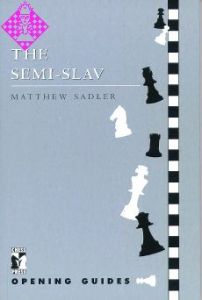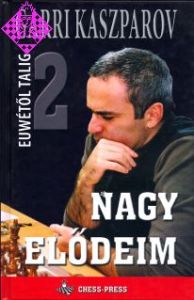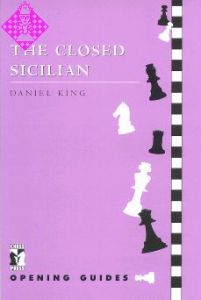The Sicilian Taimanov (1.e4 c5 2.Nf3 e6 3.d4 cxd4 4.Nxd4 Nc6) is one of Black's most flexible ways of meeting 1.e4. It leads to the kind of tense, dynamic positions that appeal to players with counter-attacking inclinations, such as Judit Polgar, Joel Lautier and Vasiliy Ivanchuk. Indeed, Bobby Fischer turned to the Taimanov in the decisive game of his famous match with Boris Spassky.
In this book Grandmaster James Plaskett explains the strategy and tactics of this popular variation. Through the use of model games for both sides, the author provides a thorough grounding in the key ideas, so that readers can quickly and confidently start to use the Sicilian Taimanov in their own games.
In this book Grandmaster James Plaskett explains the strategy and tactics of this popular variation. Through the use of model games for both sides, the author provides a thorough grounding in the key ideas, so that readers can quickly and confidently start to use the Sicilian Taimanov in their own games.
·Written by a leading expert on the Sicilian Taimanov, former British Champion James Plaskett
·Explains the basic elements, strategies and tactics for both sides
·Offers an accessible, digestible blend of explanatory and theoretical material
·Provides everything you need to know to start playing the opening straight away.
James Plaskett is one of Britain's most imaginative and exciting players. His uncompromising approach has provided great entertainment for spectators over the years and resulted in several outstanding tournament victories, including the 1990 British Championship, where he finished ahead of numerous grandmasters, including Michael Adams, Matthew Sadler and Jon Speelman. He is married to the poet and writer Fiona Pitt-Kethley, and they have one son, Alexander.
The Sicilian Taimanov (1.e4 c5 2.Nf3 e6 3.d4 cxd4 4.Nxd4 Nc6) is one of Black's most flexible ways of meeting 1.e4. It leads to the kind of tense, dynamic positions that appeal to players with counter-attacking inclinations, such as Judit Polgar, Joel Lautier and Vasiliy Ivanchuk. Indeed, Bobby Fischer turned to the Taimanov in the decisive game of his famous match with Boris Spassky.
In this book Grandmaster James Plaskett explains the strategy and tactics of this popular variation. Through the use of model games for both sides, the author provides a thorough grounding in the key ideas, so that readers can quickly and confidently start to use the Sicilian Taimanov in their own games.
In this book Grandmaster James Plaskett explains the strategy and tactics of this popular variation. Through the use of model games for both sides, the author provides a thorough grounding in the key ideas, so that readers can quickly and confidently start to use the Sicilian Taimanov in their own games.
·Written by a leading expert on the Sicilian Taimanov, former British Champion James Plaskett
·Explains the basic elements, strategies and tactics for both sides
·Offers an accessible, digestible blend of explanatory and theoretical material
·Provides everything you need to know to start playing the opening straight away.
James Plaskett is one of Britain's most imaginative and exciting players. His uncompromising approach has provided great entertainment for spectators over the years and resulted in several outstanding tournament victories, including the 1990 British Championship, where he finished ahead of numerous grandmasters, including Michael Adams, Matthew Sadler and Jon Speelman. He is married to the poet and writer Fiona Pitt-Kethley, and they have one son, Alexander. | EAN | 9781901259018 |
|---|---|
| Weight | 260 g |
| Manufacturer | Chess Press |
| Width | 15.3 cm |
| Height | 23.4 cm |
| Medium | Book |
| Year of Publication | 1997 |
| Author | James Plaskett |
| Language | English |
| ISBN-10 | 1901259013 |
| ISBN-13 | 9781901259018 |
| Pages | 144 |
| Binding | paperback |
008 Bibliography
009 Introduction
013 1. 5.Nc3 a6 6.g3
026 2. 5.Nc3 a6 6.Be3 Qc7 7.Bd3
042 3. 5.Nc3 a6 6.Be2 Qc7: Introduction
057 4. 5.Nc3 a6 6.Be2 Qc7: Main Line
074 5. 5.Nc3 a6 6.Be2 Nge7
084 6. 5.Nc3 a6 6.Be3 followed by f2-f3 and Qd2
096 7. 5.Nc3 a6 6.Nxc6 and 6.f4 Qc7 7.Nxc6
109 8. 5.Nc3 a6 6.f4 and 7.Nf3
119 9. 5.Nc3 a6 6.Bf4
127 10. 5.Nb5
142 Index of Complete Games
009 Introduction
013 1. 5.Nc3 a6 6.g3
026 2. 5.Nc3 a6 6.Be3 Qc7 7.Bd3
042 3. 5.Nc3 a6 6.Be2 Qc7: Introduction
057 4. 5.Nc3 a6 6.Be2 Qc7: Main Line
074 5. 5.Nc3 a6 6.Be2 Nge7
084 6. 5.Nc3 a6 6.Be3 followed by f2-f3 and Qd2
096 7. 5.Nc3 a6 6.Nxc6 and 6.f4 Qc7 7.Nxc6
109 8. 5.Nc3 a6 6.f4 and 7.Nf3
119 9. 5.Nc3 a6 6.Bf4
127 10. 5.Nb5
142 Index of Complete Games
Die neue englischsprachige Reihe "Opening Guides" nimmt Abschied von den oft (aber nicht immer!) recht trockenen variantenauflistenden Referenzbüchern und versucht dem Leser lieber ausführlich die Grundelemente der Strategie und Taktik sowie ein erstes Variantengerüst einer Eröffnung auf vergleichsweise schnelle Art beizubringen. Diverse solche Versuche gab es freilich bereits, man denke nur an die "Wie spielt man..." - Reihe des Rau Verlags. Neu jedoch ist, daß der Lehrstoff konsequent über vollständige und (nicht nur in der Eröffnungsphase) kommentierte Partien dargeboten ist. Diese sind kapitelweise in strategische Einleitungen und abschließende Variantenindizes zur Übersicht eingebunden, so daß jedes Buch der Reihe auch weiterhin noch gewisse Referenzdienste leistet. Erfreulich ist zudem der saubere Druck und die zahlreichen Diagramme, die einem sogar das Buchschmökern ohne Brett erlauben. Eine interessante Reihe, die bislang die Bände "Scandinavian", "Slav", "Spanish Exchange", "Caro-Kann-Advance", "Dutch Leningrad" und "Sicilian Taimanov" umfaßt. Mir liegt nur der letztgenannte Band vor, so daß ich Unterschiede im Verhältnis Lehrcharakter und Referenzcharakter zwischen den einzelnen Bänden nicht beurteilen kann.
Der vorliegende Band behandelt in 92 Partien (meist aus den letzten Jahren) ausführlich die Varianten 1. e4 c5 2. Sf3 e6 3. d4 cd4: 4. Sd4: Sc6 5. Sc3 (ein Kapitel für 5. Sb5) a6 und nun 6. g3, 6. Le2 Dc7, 6. Le2 Sge7, 6. Le3 (nebst f3, Dd2), 6. Sc6:, 6. f4 sowie 6. Lf4, und damit eigentlich das Paulsen- und das Taimanov-System, folgt man jedenfalls der Terminologie von Taimanov selbst, bei dem (so in seinem Buch "Sizilianisch siegen") nur die Varianten mit 6. ...Sge7 die Bezeichnung Taimanov-System erhalten. Freilich hat sich Taimanov auch um die Erforschung des Paulsen-Systems sehr verdient gemacht. Hier lag ein Buch vor, das ich mit viel Interesse las und weiterempfehlen kann, wenngleich an der einen oder anderen Stelle der höherklassige Turnierspieler vielleicht doch nicht ganz auf ein Referenzwerk zur Ergänzung verzichten wird.Helmut Riedl, Rochade Europa 7/97
Der vorliegende Band behandelt in 92 Partien (meist aus den letzten Jahren) ausführlich die Varianten 1. e4 c5 2. Sf3 e6 3. d4 cd4: 4. Sd4: Sc6 5. Sc3 (ein Kapitel für 5. Sb5) a6 und nun 6. g3, 6. Le2 Dc7, 6. Le2 Sge7, 6. Le3 (nebst f3, Dd2), 6. Sc6:, 6. f4 sowie 6. Lf4, und damit eigentlich das Paulsen- und das Taimanov-System, folgt man jedenfalls der Terminologie von Taimanov selbst, bei dem (so in seinem Buch "Sizilianisch siegen") nur die Varianten mit 6. ...Sge7 die Bezeichnung Taimanov-System erhalten. Freilich hat sich Taimanov auch um die Erforschung des Paulsen-Systems sehr verdient gemacht. Hier lag ein Buch vor, das ich mit viel Interesse las und weiterempfehlen kann, wenngleich an der einen oder anderen Stelle der höherklassige Turnierspieler vielleicht doch nicht ganz auf ein Referenzwerk zur Ergänzung verzichten wird.Helmut Riedl, Rochade Europa 7/97
More from Chess Press
-
 The Caro-Kann Advance€18.50
The Caro-Kann Advance€18.50 -
 Semi Slav€22.95
Semi Slav€22.95 -
 Garri Kaszparov 2€24.95
Garri Kaszparov 2€24.95 -
 The Closed Sicilian€16.95
The Closed Sicilian€16.95 -
 Garri Kaszparov 1€19.95
Garri Kaszparov 1€19.95 -
 Garri Kaszparov 3€19.95
Garri Kaszparov 3€19.95 -
 Garri Kaszparov 4€19.95
Garri Kaszparov 4€19.95 - More from Chess Press

